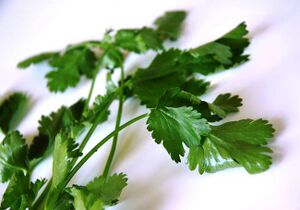Coriander

Plant name: Coriandrum sativum
Indian name: Dhania
Leaves and stems
The leaves are variously referred to as coriander leaves in Britain; cilantro (from the Spanish name for the plant) in the United States, and dhania in the Indian subcontinent. The leaves, and especially the stems, have a very different taste from the seeds, similar to parsley but "juicier" and with citrus like overtones. Some people instead perceive an unpleasant "soapy" taste and/or a rank smell. This is believed to be a result of an enzyme that changes the way they taste coriander leaves, a genetic trait, but has yet to be fully researched.
The fresh leaves and stems are an essential ingredient in many Vietnamese foods, Asian chutneys, Mexican salsas and guacamole, and occasionally is used in sushi rolls. Chopped coriander leaves are also used as a garnish on cooked dishes such as daal and many curries. As heat diminishes their flavour quickly, coriander leaves are often used raw or added to the dish right before serving. In some Indian and Central Asian recipes, coriander leaves are used in huge amounts and cooked till they dissolve into sauce and their flavour mellows. Another factor that dictates the quality of flavour is the time when coriander is harvested. If its roots consistently stay at a temperature above 75 degrees Fahrenheit, the herb will quickly bolt, causing its leaves and stems to yield a bitter flavour and become quite chewy. At this point, made evident by the thinner and finer leaves, it is practical to harvest only the coriander seeds, since the stems and leaves are no longer usable as food.
Coriander leaves were formerly common in European cuisine but nearly disappeared before the modern period. Today Europeans usually eat the leaves and stems only in dishes that originated in foreign cuisines; in Portugal, however, it is still an essential ingredient in many traditional dishes. To use the stems, separate cilantro leaves from stems. Chop stems finely and add them to your dish a minute or two before serving, just giving them time to warm up and disperse their flavour. The leaves will remain beautiful and fresh if you use them to garnish individual plates.
The fresh coriander herb is best stored in the refrigerator in airtight containers, after chopping off the roots. The leaves do not keep well and should be eaten quickly, as they lose their aroma when dried or frozen.
Coriander leaves are great with:
-
Coriander seeds
-
Coriander roots
Coriander seeds (fruit)
The dry fruits are known as coriander seeds or coriander seeds. In some regions, the use of the word coriander in food preparation always refers to these seeds (as a spice), rather than to the plant itself. The seeds have a lemony citrus flavour when crushed, due to the presence of the terpenes linalool and pinene. It is also described as warm, nutty, spicy, and orange flavoured. They are usually dried but can be eaten green.
If the fruit is obtained in its natural form, it can later be dried in the sun. Most commonly, it is bought as whole dried seeds, but it can also be found as a powder. When grinding at home, it can be roasted or heated on a dry pan briefly to enhance the aroma before grinding it in an electric grinder or with a mortar and pestle; ground coriander seeds lose their flavour quickly in storage and are best ground as only needed. For optimum flavour, whole coriander seed should be used within six months, or stored for no more than a year in a tightly sealed container away from sunlight and heat.
Coriander seed is a key spice in garam masala and Indian curries, which often employ the ground fruits in generous amounts together with cumin. It also acts as a thickener. Roasted coriander seeds, called dhana dal, are also eaten as a snack. It is also the main ingredient of the two south Indian gravies: sambhar and rasam.
Outside of Asia, coriander seed is an important spice for sausages in Germany and South Africa (see boerewors). In Russia and Central Europe coriander seed is an occasional ingredient in rye bread as an alternative to caraway. Apart from the uses just noted, coriander seeds are rarely used in European cuisine today, though they were more important in former centuries.
Coriander seeds are also used in brewing certain styles of beer, particularly some Belgian wheat beers. The coriander seeds are typically used in conjunction with orange peel to add a sultry citrus character to these styles of beer.
Grind the dried seeds as they are with a coffee grinder when you need them.
Coriander seeds are great with:
Coriander roots
Coriander roots are used in a variety of Asian cuisine. They edible and are commonly used in Thai dishes.
How much does one cup of coriander leaves weigh?
Estimated US cup to weight equivalents:
| Ingredient | US Cups | Grams | Ounces |
|---|---|---|---|
| Chopped coriander | 1 Cup | 25 g | 1 oz |
Conversion notes:
Every ingredient has a cups to ounces or grams conversion table. Search for the ingredient, cup to weight conversions are at the end of each ingredient page.
We also have a generic conversion table and a portions per person lookup.
Find recipes that contain 'Coriander'
#coriander #beansandpulses #avocados #coffeegrinder #frozen #citrusfruit #onions #mushrooms #spices #apples #pork

